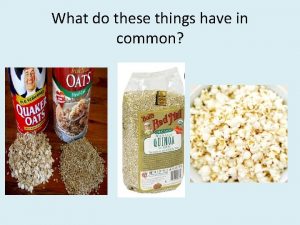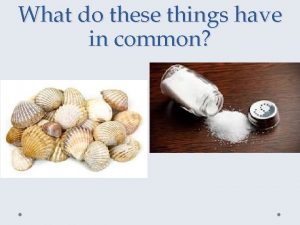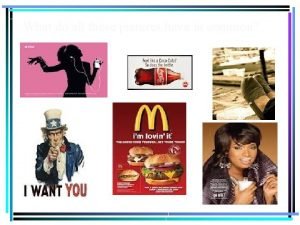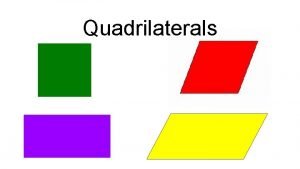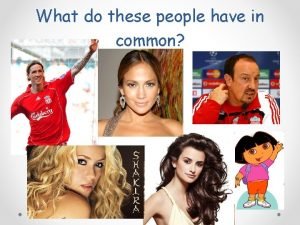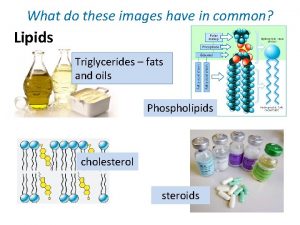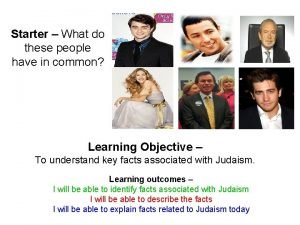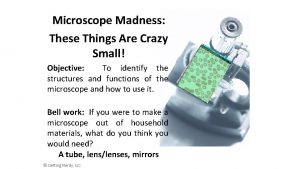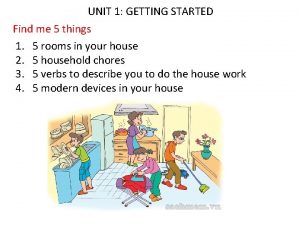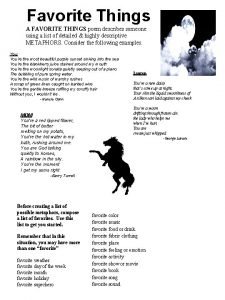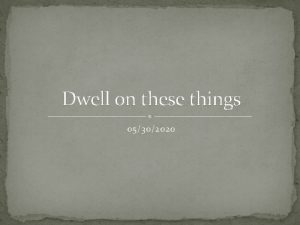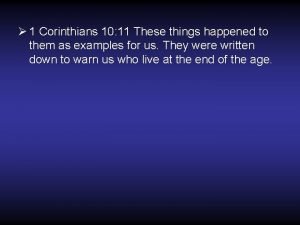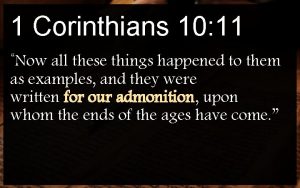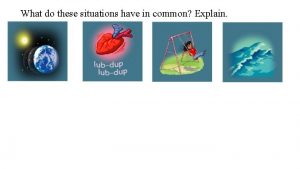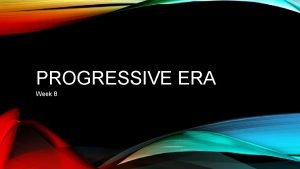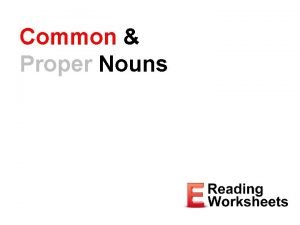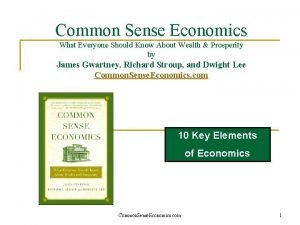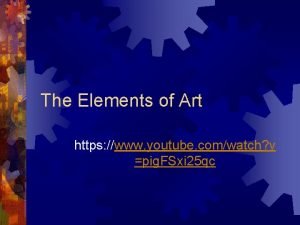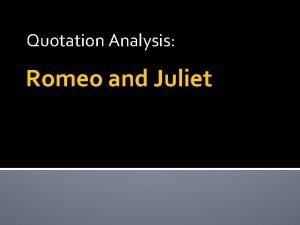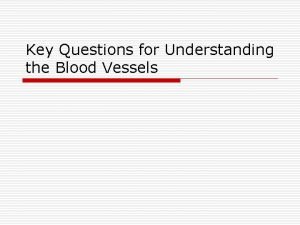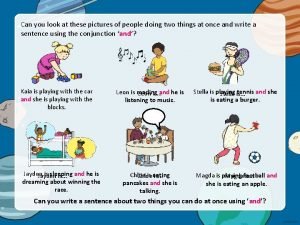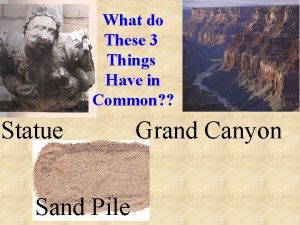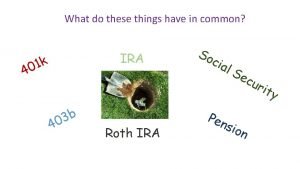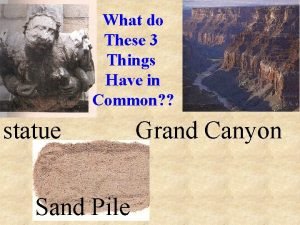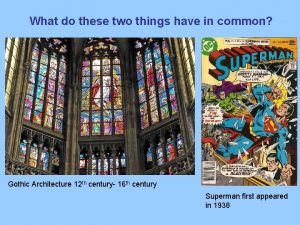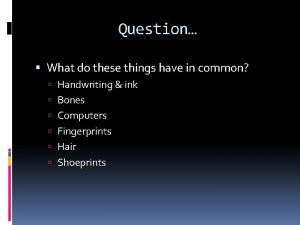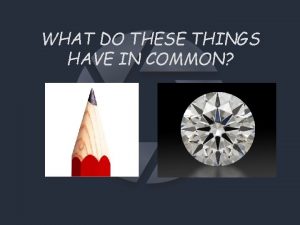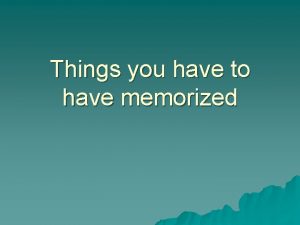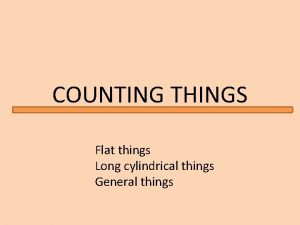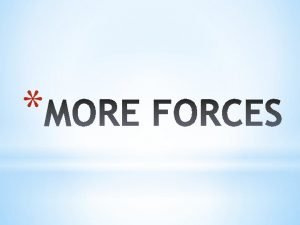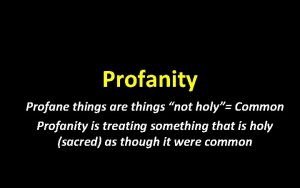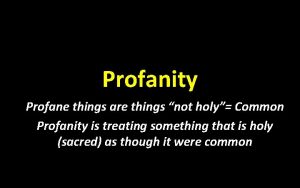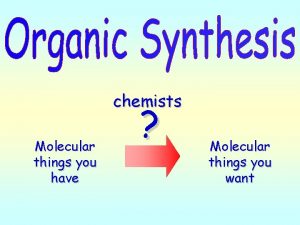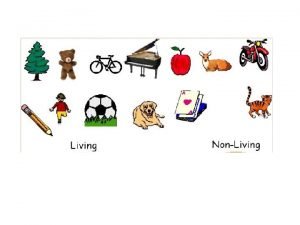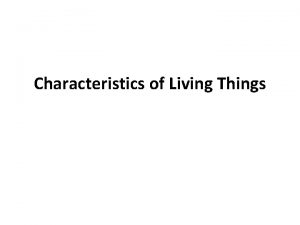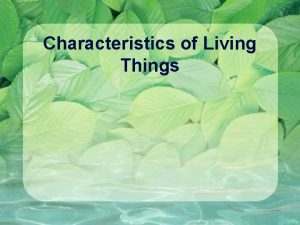What do these things have in common What












































- Slides: 44

What do these things have in common?

What if we added these to the list?

Ummm…what? • Porpoise teeth, rice, wheat, shells, tulip bulbs, olive oil, cattle, salt, dried fish, furs, precious stones, gold and silver? • MONEY!!!

Money, Credit & Interest SSEMI 1 The student will describe how households, businesses and governments are interdependent and interact through flows of goods, services and money. The student will evaluate the costs and benefits of using credit.

What Is Money? Explain the role of money and how it facilitates exchange. Money is anything that serves as a medium of exchange, a unit of account, and a store of value.

What are the 3 ways Money is used? 1. Money as Medium of Exchange – People accept money in trade for goods and services. • Barter: Ever used this method? ? ? – Direct exchange of goods or services

What are the 3 ways Money is used? 2. Money as a Unit of Account – The value of a good or service can be measured with money. – Ex: car with a price of $2, 000 is worth twice as much as a car with a price of $1, 000.

What are the 3 ways Money is used? 3. Money as a Store of Value – something that keeps its value if it is stored rather than used. – Money can be saved and used in the future.

How does Money flow in the Free Market Economy? Remember this? • Free market economy: – households and – business firms use markets to exchange money and products. • Households own the factors of production and consume goods and services. Circular Flow Diagram of a Market Economy Households pay firms for goods and services. Product market monetary flow physical flow Firms supply households with goods and services. Households supply firms with land, labor, and capital. Firms pay households for land, labor, and capital. physical flow monetary flow Factor market

How is Money Valued? 1. Commodity money consists of objects that have value in themselves. If cigarettes become an informal currency in prison, for example, smoking a cigarette can become a costly activity! EX:

How is Money Valued? Representative money has value because the holder can exchange it for something else of value. 2. EX: CHECKS!! (Your debit card. )

How is Money Valued? 3. Fiat money, also called “legal tender, ” has value because the government decreed that is an acceptable means to pay debts. $$$ Because the Government said so!! EX: Govt BONDS

Why is an American Dollar worth $1. 00? • In the beginning, the American Dollar was on a gold standard. – That meant the government had actual gold stored for every dollar • Today our money is Fiat money – It has value because the government says so. • So what's all that stuff printed on bills? • How do we know the bill is not a fake?

1. 2. 3. 4. 5. 6. What are the 6 Characteristics of Money? Write on the back of your E? s! Durability: withstands wear and tear Portability: easily carried Divisibility: easily and accurately divided Uniformity: each piece is the same Limited Supply: scarcity Acceptability: people accept it as money

How has Banking evolved in the 20 th Century? • The Federal Reserve Act of 1913 created the Federal Reserve System. – The Federal Reserve System served as the nation’s first true central bank. • The Banking Act of 1933 created the Federal Deposit Insurance Corporation (FDIC). – Today, the FDIC insures customers’ deposits up to $250, 000—per depositor. – The nation was also taken off of the gold standard. – Failed Bank List

1. 2. 3. • What do Banks offer? Storing Money Issue Credit Cards Saving Money 4 most common options: 1. Savings Accounts 2. Checking Accounts 3. Money Market Accounts 4. Certificates of Deposit (CDs) 4. Loans 5. Mortgages • A mortgage: a specific type of loan used to purchase real estate

REVIEW…How do Banks Make a Profit? • Largest source of income for banks: INTEREST from loans. • Interest is the price paid for the use of borrowed money. How Banks Make a Profit Money leaves bank Money enters bank Interest and withdrawals to customers Deposits from customers Interest from borrowers BANK Fees for services Bank retains required reserves Money loaned to borrowers: • business loans • home mortgages • personal loans Bank’s cost of doing business: • salaries • taxes • other costs

What are the different Types of Financial Institutions? • Commercial Banks: checking services, accept deposits, and make loans. • Savings and Loan Associations: originally chartered to lend money for home-building in the mid-1800 s. • Savings Banks: originally served people who made smaller deposits and transactions than commercial banks wished to handle. • Credit Unions: cooperative lending associations for particular groups, usually employees of a specific firm or government agency. • Finance Companies: make installment loans to consumers.

Banking in the Computer Age Automated Teller Machines (ATMs)-deposit money, withdraw cash, and get account information. Debit Cards-used to withdraw money directly from a checking account. Automatic Clearing Houses (ACH)-transfers funds automatically from customers' accounts to creditors' accounts. Home Banking-allow customers to check account balances and make transfers and payments via computer. Stored Value Cards- (GIFT CARDS) embedded with magnetic strips or computer chips with account balance information.

What is Credit? • CREDIT = LOANS • company is willing to loan you money at a set interest rate. – Credit cards are just loans

What is Interest? • Interest how much the company is expecting you to pay for that loan. – 2 most common are simple interest and compound interest. Rate Calculator

What is Simple Interest? READ 1 st! • Borrow $100 from you …Thanks! • @10% simple interest (one set amount per year) – $100 is the principal or borrowed amount – 10% is the interest rate • 1 year from now calculate the interest by multiplying $100 by 10% (or. 10) • $100 x. 10 = $10 • Interest for the year = $10 • I now owe $110

Simple Interest (Cont. ) • Simple interest the interest ($10) does not become part of the principal ($100) • Next year when interest is calculated, still 10% of $100 (or $10). –Simple interest is NOT added to the principal. –Interest generated each year can. NOT get bigger.

What is Compound Interest? • Simple interest is rarely used. (Remember how banks make money? ? ) • Most lenders use Compound Interest--interest is compounded or added to the principal.

Compound Interest (cont) • Back to the $100 you lent me. Now using Compound Interest. • 1 year from now I haven’t paid off the loan, interest is calculated again on the new principal – $110 x 10% – $11 • The $11 is then added to the principal and the new principal is $121

Simple vs Compound Year Amount Owed Interest Made 1 2 3 4 5 6 7 8 9 10 $100 $110 $120 $130 $140 $150 $160 $170 $180 $190 $10 $10 $100 $110 $121 $133. 10 $146. 41 $161. 05 $177. 15 $194. 86 $214. 33 $235. 76 $10 $11 $12. 10 $13. 31 $14. 64 $16. 10 $17. 71 $19. 47 $21. 43 $23. 58

Loans • Nearly everyone uses compound interest. • But they do not compound the interest every year. • They compound it every day. Compound Interest Calculator Web. Math

The Complicated Math…just read. • When interest is compounded daily, it means that they add the interest to the principal every day. • However, if the interest is 10% per year, they don’t add 10% every day, they add 10/365% every day. • Even though this seems rather small, trust me, it makes the debt rise even faster.

Are you worthy LOAN worthy? 4 C’s of Loans 1. Capacity – your ability to pay the debt. - where you work, - how long you’ve worked there - and how much you make Work + Time @ Work + Income = Capacity

When you apply for a loan, how do they determine if you get the loan? Are you worthy? The four C’s determine if you get a loan: 2. Capital – Your regular income, plus the money in your savings account Income + Savings = Capital

Are you LOAN worthy? 4 C’s The four C’s determine if you get a loan: 3. Character – Willingness to pay debts - They look at your past borrowing and your credit rating

When you apply for a loan, how do they determine if you get the loan? Are you worthy? 4 . Collateral – Property used to secure a loan - If you default on the loan, they get to keep the property

Credit Rating • Credit Rating: how much (or little) of a credit risk you are based on your history. • 3 companies (credit bureaus) in America keep track of your credit rating. – Equifax – Trans. Union – Experian • Any creditor can contact them and see all of your past credit history. – You can contact them too

But, how do I (a student) get a Great credit score? ? • Credit Cards for the Newbies • What is in my credit score?

Some Terms and Stuff • Annual Percentage Rate (APR): interest rate on the loan is in a yearly percentage rate – This does not mean it isn’t compounded daily • Finance Charge: Some loans charge you a fee every month or year to have the service. (This fee is added into the loan. ) • Minimum Payment: Most loans require you to make a payment of a minimum amount each month.

Some Terms and Stuff • Fixed Interest Rate: means the interest rate does not change for as long as you have the loan • Variable Interest Rate: means the interest rate changes as the Fed changes the Prime Rate. – The is why so many houses are foreclosing right now

Credit Cards • Serious Credit Damage if you do not know how credit cards work! • Every time you buy something with a credit card, the company is loaning you money at the preset interest rate (compounded daily).

Credit Cards…just read! • Credit Card company makes you pay a minimum amount--- just barely enough so that you eventually pay off the card. • You can---and should--- pay more than the minimum • But they like it when you don’t. It means more interest gets compounded.

Debit Cards vs Credit Cards…more to come on this topic tomorrow. • Debit cards are like checks – They take money from your checking account • Credit cards are loans – They are a loan with interest that you must pay back

Listen. New Credit Card Laws.

Now how do you use credit to your advantage? • Complete your E? s!

Section 1 Assessment 1. Two units of the same type of money must be the same in terms of what they will buy, that is, they must be (a) divisible. (b) portable. (c) acceptable. (d) uniform. 2. What is the source of fiat money’s value? (a) it represents the value of another item (b) government decree (c) presidential pardon (d) it is equal to the value of the stock market Want to connect to the PHSchool. com link for this section? Click Here!

Section 1 Assessment 1. Two units of the same type of money must be the same in terms of what they will buy, that is, they must be (a) divisible. (b) portable. (c) acceptable. (d) uniform. 2. What is the source of fiat money’s value? (a) it represents the value of another item (b) government decree (c) presidential pardon (d) it is equal to the value of the stock market Want to connect to the PHSchool. com link for this section? Click Here!

 What do these things have in common
What do these things have in common What do these 3 things have in common questions
What do these 3 things have in common questions What do all of these pictures have in common?
What do all of these pictures have in common? What do these pictures have in common
What do these pictures have in common What are the things common to these pictures
What are the things common to these pictures What do all quadrilaterals have in common
What do all quadrilaterals have in common What do these people have in common?
What do these people have in common? What do these images have in common?
What do these images have in common? What do these pictures have in common
What do these pictures have in common What do these pictures have in common
What do these pictures have in common What do these people have in common?
What do these people have in common? What do these images have in common
What do these images have in common Who is he
Who is he A cube has 6 faces and 8 vertices
A cube has 6 faces and 8 vertices Hagfish slime macromolecule
Hagfish slime macromolecule Because of libraries we can say
Because of libraries we can say Think on these things
Think on these things Microscope madness vocabulary answer key
Microscope madness vocabulary answer key These things happened as examples
These things happened as examples Find these things in unit 1
Find these things in unit 1 Poem about favorite things
Poem about favorite things Even angels long to look into these things
Even angels long to look into these things Proverbs 6 16 19
Proverbs 6 16 19 Dwell on these things
Dwell on these things All these things happened to them as examples
All these things happened to them as examples These things are written for our example
These things are written for our example What do they have in common? explain
What do they have in common? explain The common purpose of these legislative acts was to
The common purpose of these legislative acts was to Venn diagram of living and non living things
Venn diagram of living and non living things Life processes movement
Life processes movement What book
What book Common things everyone should know
Common things everyone should know What do arthropods have in common
What do arthropods have in common Greatest common factor of 54 and 72
Greatest common factor of 54 and 72 Common anode and common cathode
Common anode and common cathode Factor tree of 56
Factor tree of 56 Factors of 54
Factors of 54 Common factors of 20 and 24
Common factors of 20 and 24 Highest common factors and lowest common multiples
Highest common factors and lowest common multiples Shapes that have smooth even edges are measurable
Shapes that have smooth even edges are measurable These violent delights have violent ends meaning
These violent delights have violent ends meaning What do these pictures show what are they
What do these pictures show what are they These vessels have thicker walls and a heavier tunica media
These vessels have thicker walls and a heavier tunica media Pictures of
Pictures of He was over the moon when he won the prize
He was over the moon when he won the prize
